
Diary: The garden in February 2000

 | Diary: The garden in February 2000 |

|
Three buzzards were spotted, flying low around the house and garden on the 3rd, being mobbed by several rooks from the nearby rookery. There are about 20 nests in trees to the northwest of the garden in our neighbour's garden. There is a lot of activity at present at the nests and buzzards are not welcome. On the morning of the 4th it was foggy and there was a strong southerly wind. This did not stop the 'storm cock' singing high in the trees near the house almost before first light. It was to remain wet and stormy for several more days.
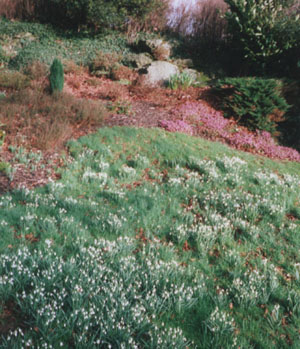
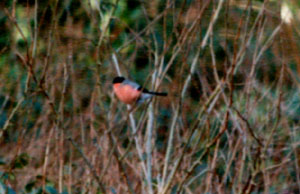
On the 8th male and female bullfinches were seen again on the snowberry near the house. We get a good view of this area of the garden from an upstairs window; a pair of binoculars is kept handy so that a spot of bird watching can be done from time to time. I was able to photograph the male bullfinch from the same window. The buzzards returned on the 10th and flew around the garden again, but this time they did not attract the attention of the rooks. They soon went on their way over the treetops and out of sight. After the recent gales it was good to have a calm sunny day on the 13th. Woodpeckers were busy drumming on their favourite 'sounding' branches. As the day was calm the sound was carrying well across the fields and answering drumming, at different pitches, could be heard nearby and from the woodland at Treffos just less than 1 km away. Several great tits and blue tits were investigating the nesting boxes we have on trees near the house and in the wood. We have had several wooden boxes of various home made design and have had a high occupancy rate. A pair of nuthatches occupied the same box for about 7 years before one of the pair died. In the first year I put up the box they were interested within 20 minutes. It proved satisfactory, but only after some slight enlargement of the hole and plastering with mud of several joints in the woodwork! After 2 years of successful breeding the box had to be moved. The tree was diseased and becoming dangerous and as it was very close to the house and was felled. The same box was re-erected on another tree at the other side of the house. This did not deter the nuthatches, they soon found the box and continued to nest there for another 5 years. Sadly, we have not had any more nuthatches in our boxes, the nut hatch box was taken over by great tits. There are several pairs of nuthatches around but they seem to prefer natural nesting places. Some of the wooden nesting boxes have come to the end of their useful life and need replacing. This year we are trying for the first time Schwegler boxes of German origin made of a composite of wood chips, clay and cement. They are said to last at least 25 years! A walk around the garden on the 14th showed that several plants were showing signs of spring growth. In a damp border Primula denticulata plants were showing the first flowers and buds were well developed on the Saxifraga oppositifolia on the rockery.
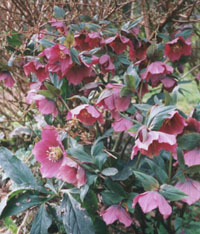
The first dwarf daffodil, in the patch that we planted in the autumn, has suddenly sprung into flower. Plants of the Welsh poppy, which had died back almost to nothing, have greened up a lot in the last few days. Some of the patches of heathers around the borders are now well into flower, especially the Erica carnea Springwood Pink and Springwood White, while the Ruby Glow variety is just coming into flower. Molehills are being put up in the wood and along the grass verge of the drive entrance.
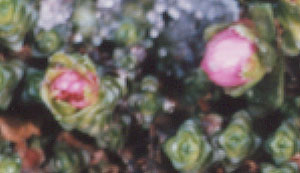
Patches of hills can also be seen in some of the nearby grassy fields. The moles are also around the garden and tunnel under the grass of the lawns looking for worms. They rarely put up molehills here but make the grass very spongy to walk on. By the time the first grass mowing needs to be done their tunnelling is extensive in some parts. We have learned to tolerate them and to share the garden with them. By the 19th the snowdrops, which have given such a good display this year, are just passing their best. A few early daffodils are appearing and there are still the crocuses but today, although sunny, it is not warm enough for the flowers to open. The purple hellebore is now well into flower along with the green in the herbaceous border. On the rockery there are flowers open on a dwarf white flowered Rhododendron. In the wood well-formed leaves are out on several seedling sycamores while on some mature trees the buds look quite swollen and green. In the greenhouse a lot of shoots have formed on the now cut back chrysanthemum plants still in their pots. It will soon be time to take cuttings and prepare for this year's display in the autumn. The bottom heated propagating frame, on the bench inside the greenhouse, runs all winter and is full of cuttings including several varieties of fuchsias struck in the autumn. These will be brought on to plant in large earthenware pots early in the summer. The summer season is short here in the northwest and plants do best if brought on in the greenhouse and planted out when fear of a late frost has passed.
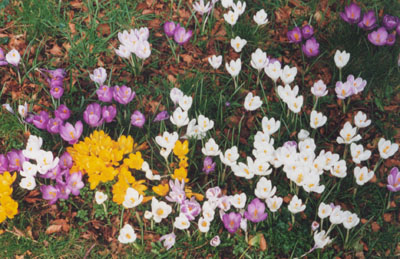
The 21st was a sunny and warmer day with the temperature reaching 10.2C. This was what the crocuses had been waiting for and they duly opened their flowers to give us a good display. In contrast the next day was dull and cooler, the crocuses remained shut. A walk around the nearby lanes on the 22nd revealed 3 campions plants struggling in flower, they could be the same plants I have been looking at through the winter. I also spotted two yellow lesser celandines and one dandelion in flower. There was plenty of yellow gorse in flower looking bright in the dull light. I saw several wrens working their way along the hedgerows but there were no other birds of interest. We have seen very few winter visitors this year, as the weather has been very mild. In some years it has been possible to see a hundred or more redwings and fieldfares in the fields along my walk, but none today. More gales and rain on the 27/28th keeping the ground very wet. There was water standing on some parts of the garden and the old 'cricket' field opposite the house had large pools of water on it again. Early morning fog on the morning of the extra day on the 29th was soon replaced by brighter weather. The mistle thrushes were singing well in the treetops and have now been joined by a chorus of great tits with their familiar 'teacher-teacher' calling. We have been disappointed not to have seen any siskins around the garden so far this year. We have seen and recorded them for the past 2 Februarys. Later in the day, our pair of semi resident pheasants were displaying on the lawn.
Document dated: 23 May 2000. This page is part of the site maintained at http://www.llansadwrn-wx.co.uk
Copyright ©: 2000 Donald and Patricia Perkins